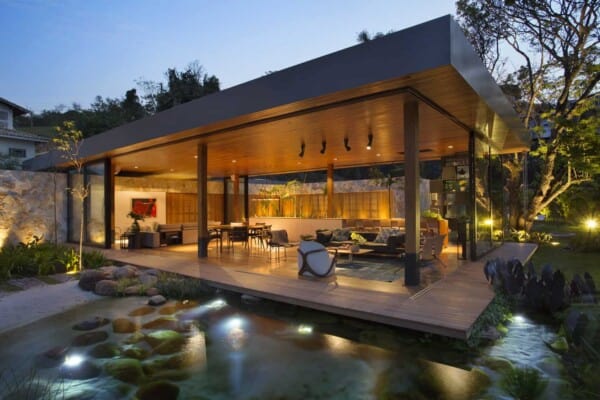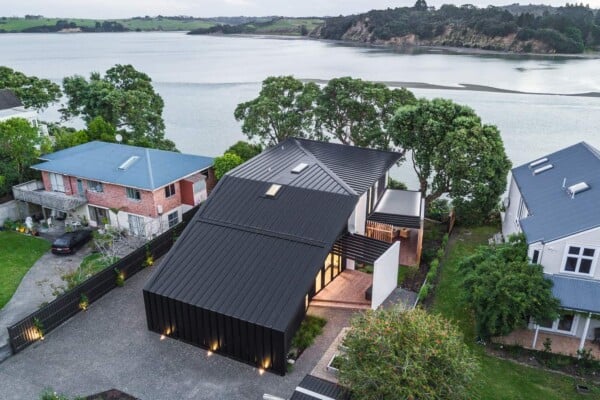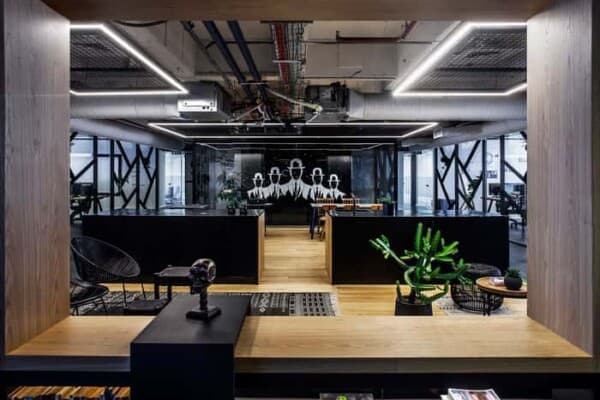Melbourne-based studio Insite Design has sent us photos of the Base Camp Chewton project.
This compact, climate & occupant adaptable weekend retreat is located on a sloping site in Chewton, a town in central Victoria, Australia.
Recently shortlisted at the World Architecture Festival Awards, Base Camp Chewton can be booked all year round from $195 to $250 Australian dollar per night, depending on the season.
Base Camp Chewton by Insite Design
“Overview
A compact, climate & occupant adaptable weekender, located in semi bush, sitting off the land yet immersed within, robust and singular form, multi-layered in detail.
Context
This house is situated one & a half hours northwest of Melbourne, on the edge of the Great Dividing Range, in a region of rolling hills, eucalyptus forests and rocky outcrops. It is also ‘gold country’: site of the world’s richest shallow alluvial gold fields, and scene of the Victorian Gold Rush of the 1850’s. This has left enduring marks on the landscape and towns: pockmarked with disused mineshafts, house sites and relics.
Siting
The sloping site overlooks a gulley of native grasses and bush, with the higher ground characterised by exposed rock and aged gum trees. The building is situated across the line of the contours, appearing ‘abstracted’ to the land, street and tree backdrop beyond.
The building is partly cut into the land reducing height, and giving the sense it sits within and over the land at the same time. As the cut rock is weathered siltstone no structural retention was necessary, the exposed stone seams providing a raw relationship between house and (modified) terrain.
Climate & Design Response
The house is located in foothills in a micro climate; moderate with extremes: scorching heat (40C+) with associated drought in summer, sub zero nights in winter, high sunshine hours, low rainfall. These conditions were fundamental to the concept for the building; the aim to be climate responsive.
The buildings’ long façade is north orientated maximising passive solar heating, with large west facing double glazed doors opening the living space to a balcony with views down the gulley. The south facade, predominantly bedrooms and bathhouse, has smaller windows that provide ventilation, offering subtler glimpses of rock and woodland above, whilst minimising heat loss.
Both bathroom & bathhouse are located as a block at the east end of the plan, accessed directly from both external & internal spaces, which suits a house that is used as much from outside as the inside. Stone-paved terraces to each side of the house, allow outdoor living in most weather conditions, connect to the building via decks and platform steps.
Supersized steel sliding screens allow the north façade to be adapted to be fully or part shaded, or opened up completely to let autumn & winter sun into the living areas, whilst a shade blind to the western balcony creates a semi-outdoor room, mitigating late afternoon sun. The screened north façade veranda can be expanded into the tatami space via a room-sized sliding door, whilst the day bed, nestled under the top bed of the bunkroom facilitates an intimate lounge.
The interior is heavily cross ventilated via louvre windows and sliding doors, assisted by ceiling fans, drawing the south-westerly winds up the slope and into house. The rainwater tank, directly under the front section of the house, aids cooling in summer.
Although the building is easily opened up, it can also be effectively closed down and made snug, which is crucial through the winter months. The scale of the building assists this, with the support of a slow combustion fire, capably heating the entire insulated interior.
Materiality
External materials were selected to express a simple strong form, whilst the interior has greater layering to add warmth and detail to the overall material palette: evident as one composition when the building is opened up. Principle materials used, both as off the shelf & custom made items, included cement sheet, zincalume standing seam cladding, galvanised steel screens, windows & balustrades, recycled ironbark, locally sourced stone, plantation ply, marmoleum, tatami & glass mosaic tiles.
Colours used were earthy, with the exterior a combination of tonal shades of the gum trees’ bark. The interior uses darker colours & tones, creating a calm refuge from the bright light, whilst framing windows & openings for focussed views.
Sustainability
Environmentally sustainable features include super insulated floor, wall & roof voids, shaded double glazed low e glass, solar hot water, rainwater tank, on-site managed black & grey water system, and provision for future grid interactive solar power, which when implemented will make the house fully self sustainable.
Experimental & Interactive
– Two-thirds size / one room wide house
The project is a test case for a ‘two-thirds’ size house; smaller than typically built (particularly in Australia where space is not a premium), designed to use and consume less. It is compact yet multi functional, with adaptable spaces that open & close to transform ‘rooms’. The house comfortably sleeps seven within 27 sq.m, while the entire buildings’ footprint is 82 sq.m including decks.
The elongated form (16.5m long x 5m wide) maximises solar control, creating a ‘one room wide’ building, allowing views right through the building to the trees beyond: this reinforces the compact, open feel of the building, blurs distinctive edges of rooms, living spaces & their activities, integrating the landscape with the architecture.
The ‘two-thirds size’ explores a lifestyle potential for future reality, in which space and resources become increasingly scarce, and building, operating & energy costs are at a premium; this is a house for living sustainably & consciously.
– Bush fire zone house
The building is located in a ‘high level’ bush fire zone; materials required low combustibility, opening windows stainless steel mesh screens, all doors & openings were appropriately smoke-sealed, and the underside of the building is mesh screened to reduce risk of ember attack.
– Nature interactive house
The interior incorporates large ‘wide views’ of nature, as well as ‘close up’ landscape porthole punctuations in solid walls. These frames provide particular views of the landscape in time, allowing occupants to consciously experience the bush at different moments of day, season or weather condition. It is a space to hear the rain on roof, birds in trees, and to see stars at night.
Conclusion
This building is an innovative, multi-facetted experience for living, witnessing, conserving, immersing: a place to commune with self, space and the environment.”
Photos by: Ben Glezer
Source: Insite Design






















































